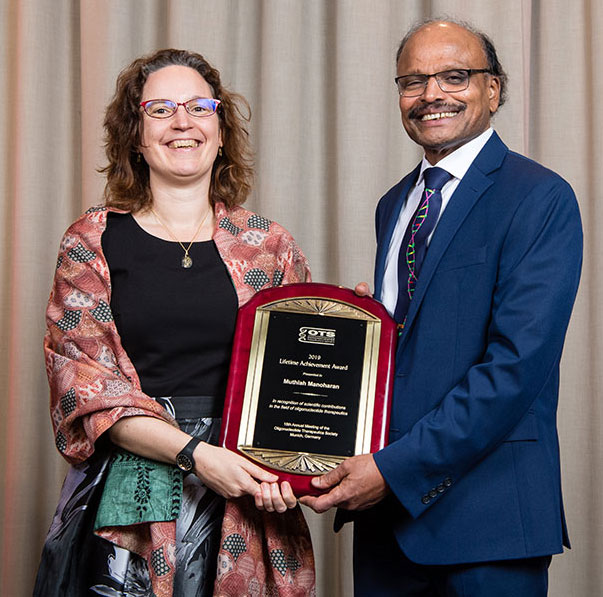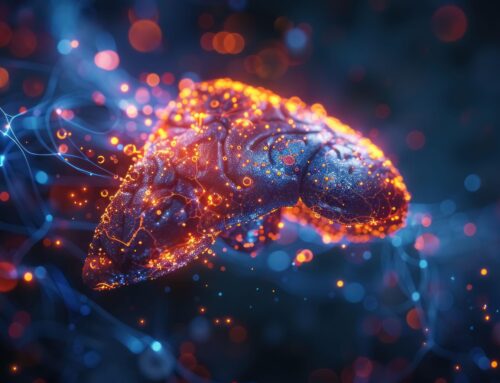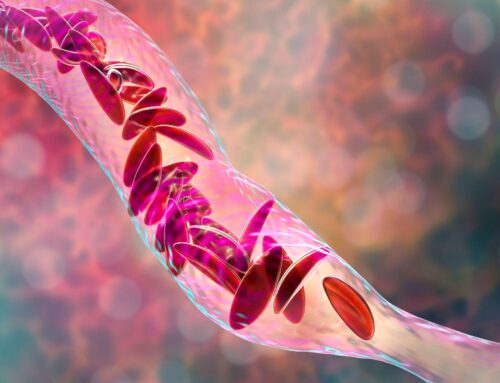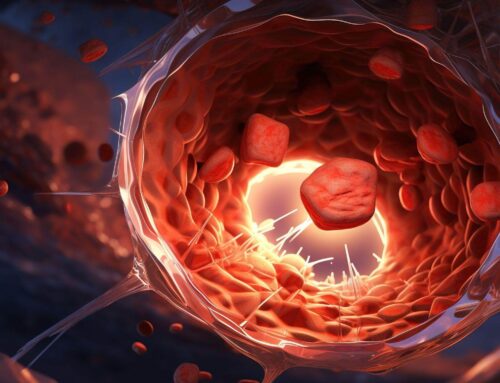Looking for something?
Interview with the 2019 OTS Lifetime Achievement Award Winner Muthiah (Mano) Manoharan


Living in the World of Oligonucleotide Therapeutics
Muthiah Manoharan, Alnylam Pharmaceuticals, Cambridge, MA 02412 USA
mmanoharan@alnylam.com
As the 2019 Lifetime Achievement Awardee of the Oligonucleotide Therapeutics Society, I would like to start by thanking the society. Thinking about my path through the world of oligonucleotide therapeutics, I find it amazing that molecules that we once thought of as totally lacking in drug-like properties, due to poor biodistribution, tissue delivery, and cell permeation capabilities, are now used to treat patients with diseases once considered “undruggable” andfunction as lifesaving drugs. I am honored and humbled to have been part of the process and have this recognition.
I was born in Madurai, Tamil Nadu, India and received my B.Sc. and M.Sc. degrees in chemistry at the American College, located in the same town. After my education, I served as a member of faculty of the College for four years before I was persuaded by my professors A. R. Venkitaraman, Divakar Masilamani, and Solomon Pappiah to study in United States. I began Ph.D. studies in chemistry with Professor Ernest L. Eliel at the University of North Carolina, Chapel Hill in 1978. I carried out synthesis and conformational analysis of heterocyclic compounds including substituted tetrahydropyrans – the skeletal compound of pyranose sugars present in GalNAc. I also attempted to correlate the pharmacological effects of molecules like phencyclidine with conformation: For example, I asked why the phenyl group prefers to have an axial orientation when positioned geminally to the methyl group in phencyclidine. Following my graduate work, attracted by the publications of Professor John A. Gerlt related to stereochemistry, 17O NMR, and enzymology of nucleic acids, I worked with him in the field of oligonucleotides at Yale University and then at University of Maryland as a Leukemia Society post-doctoral research fellow. We delineated how DNA repair enzymes uracil-DNA glycosylase and UV endonuclease V function to generate and repair abasic sites in DNA using13C-labeled oligonucleotides synthesized using phosphotriester chemistry.
I started my industrial career as an oligonucleotide chemist at Lifecodes Corporation in Valhalla, NY in 1988 in the then-nascent field of therapeutic oligonucleotides. I worked under Alan F. Cook (a superb nucleoside chemist from Roche who studied earlier with John Moffatt at Syntex) who suggested that I research the area of conjugation chemistry of oligonucleotides. When Lifecodes changed its focus from therapeutics to diagnostics in 1990, I moved to Isis Pharmaceuticals to work with P. Dan Cook and Stan Crooke. At Isis, I contributed to the team in the areas of sugar (2’-O-MOE, 2’-O-NMA, 2’-O-DMAEOE, and their cousins), linkage, and base modifications, lipidic nucleic acids, targeting ligands, conjugation chemistry, and a successful universal solid support. I also learned much about pharmacokinetics, pharmacodynamics, safety, and structural biology of oligonucleotides. In the 12 and a half years I spent at Isis, the field matured and multiple modes of antisense oligonucleotide action were identified: RNase H mechanisms, translation arrest, pseudo half-knots, immunity-based applications, and splice modulation.
In 2003, I was the first chemist hired at Alnylam by John Maraganore. There I was exposed fully to the fascinating world of Argonautes and RNA interference (RNAi). We built a chemistry team with the broad mandate to study chemical modifications and motifs, conjugation chemistry with multiple ligands, and delivery platforms (lipid nanoparticles, polymer conjugates, and complex-forming strategies), RNA synthetic and analytical methods for siRNAs. Our team pioneered the discovery and development of the chemical modifications and delivery that make RNAi-based human therapeutics possible. Our work led to ONPATTRO (patisiran), the first RNAi therapeutic approved by the FDA; FDA approval came in August 2018, and it is now approved for use in Europe, Canada, and Japan.
Our research group demonstrated for the first time the human therapeutic applications of hepatocyte-targeting GalNAc-conjugated oligonucleotides, a platform that has revolutionized the nucleic acid-based therapeutics field with several compounds in the advanced clinical trials (givosiran, inclisiran, fitusiran, virtrusiran, and lumasiran, to name a few). We expect that many of these compounds will be approved and available for the needy patients in the near future. With our academic collaborators, we developed antagomirs – the antagonists of miRNAs (adirect example of John Maraganore’s kainotomia (καινοτομία, i.e., innovation). and continue to study structural biology of RNAi; we enabled immunostimulatory siRNAs and RIG-I modulating siRNAs, nuclear RNAi, RNA activation, and selective modulation of biotherapeutics using RNAi. We also maintained productive relationships with pharmaceutical partners including Merck, Novartis, Metronix, Roche, Immunogen, Takeda-Japan, Genzyme- Sanofi and Regeneron. I continue to serve the American Chemical Society, Oligonucleotide Therapeutics Society, International Society of Nucleosides, Nucleotides, and Nucleic Acids and Gordon Research Conferences and am proud to function as an ambassador for oligonucleotide therapeutics around the globe. (“Yaadhum oore yaavarum kelir-யாதும் ஊரே யாவரும் ரேளிே-் “: i.e., We all hail from same village, and we are all kins!)
In closing I would like to share some questions that I still ponder regarding the future of the oligonucleotide therapeutic world: (“I’m still turning over stones, hoping to find somethingnew!”).
1. What are the “undruggable” diseases that oligonucleotide therapies will make treatable in the near future?
2. What other applications are there for GalNAc conjugates platform that will expand the“GalNAc universe” beyond reversirs and bis-conjugates?
3. What novel oligonucleotide chemical modification will next revolutionize the field?
4. Are there alternatives to solid-phase synthesis that will make oligonucleotide synthesis more efficient and scalable?
5. What we have done in the area of delivery is just the “end of the beginning”. How do we achieve efficient delivery of oligonucleotides to all remaining tissues?
6. How do we achieve endosomal release of oligonucleotides?
Finally, thank you again for this recognition as the Lifetime Achievement Awardee of the Oligonucleotide Therapeutics Society for the year 2019 for “commitment to the field ofoligonucleotide therapeutics through outstanding contributions to education, research, and therapeutics application”. I am grateful to my parents, mentors, heroes, colleagues, collaborators, consultants, post-docs, students, interns, friends, and family for their help, support, and understanding that made my journey in the world of Oligonucleotide Therapeutics so rewarding and memorable.
This presentation is dedicated to all of them.
Muthiah Manoharan
How did you enter the Oligonucleotide field?
- My post-doc work with Professor John Gerlt was in the area of Oligonucleotide Chemistry. We used synthetic oligonucleotides as tools to study the pathways of DNA repair enzymes.
- By the time I completed my post-doctoral research work, early in 1988, the antisense field in its infancy, and start-ups like Gilead, Hybridon, and LifeCodes had been founded.
Who has/have been the most influential person/s in your career?
- Professors A.R. Venkitaraman and Divakar Masilamani at American College, Madurai encouraged me to pursue higher education during my college days.
- Professors Ernst Eliel and John Gerlt were important mentors during my academic research career.
- Professor Gerlt was an assistant professor at the time I did my post-doctoral research with him. He patiently taught me the fundamentals of oligonucleotide chemistry.
- P. Dan Cook, who was my direct supervisor at Isis Pharmaceuticals (now Ionis), gave me the freedom to work in both nucleoside modifications and conjugation chemistry of oligonucleotides.
- The Isis team, particularly the CEO Stan Crooke, taught the importance of pharmacokinetics and biodistribution.
- The CEO John Maraganore hired me at Alnylam and allowed me to build the teams necessary to demonstrate that through chemical modifications, lipid nanoparticle formulations, and ligand conjugation siRNAs can be effective drugs.
- Inherited mentors like Bob Letsinger, Jack van Boom, Fritz Eckstein, and Michael Jung have supported me during my industry career.
- My collaborator and friend Martin Egli has for nearly 25 years nourished my interest in structure-activity relationships they relate to oligonucleotide-based therapies.
- Friends, team members and colleagues in the oligonucleotide field, too numerous to mention here, with whom I grew up in the field, have also helped me tremendously.
What was the most important milestone in your career?
- The demonstration that the pharmacokinetic behavior of oligonucleotides with phosphodiester backbones could be altered by conjugation to lipids (I termed them as “Lipidic Nucleic Acids” in 1995). This was the modification that made possible the first demonstration of in vivo gene silencing mediated by synthetic siRNAs later.
- Discovery of antagomirs during a lunch-time conversation with Markus Stoffel.
- Clinical approval of compounds derived from our teams’ efforts
- Testing the lipid nanoparticle (LNP) platform with hundreds of synthetic ionizable and cationic novel lipids and PEGs and final approval of ONPATTRO (patisiran), which is formulated in an LNP which validated both RNAi therapeutics and LNP platform
- The discovery and development of the GalNAc delivery platform: This platform has enormous potential for use in oligonucleotide therapeutics as this receptor-ligand system (“The best gift of Nature among receptor-ligand systems ” ) targets oligonucleotides to the liver hepatocytes with incredible copy number, specificity, turn-over and affinity.
- Approval of GIVLAARI (givosiran) and the expected approval of inclisiran: both are GalNAc conjugates (and many more to come!)
What lessons have you learnt that are useful for young investigators in the field?
- Kainotomia – or innovate: Invest in innovative projects that are of interest to you using all the free time available to you.
- If you build it they will come.
- Every molecule is trying to tell you a story: Be a champion of your molecules.
- Tenacity, hard work, and perseverance all pay off.
- Communication skills are important.
- Networking is critical.
What is an obstacle that you had to overcome in your career?
- Lack of sufficient communication skills.
How has your career evolved over time based on the progress of oligonucleotides over the past 30 years in science and medicine?
- Totally in sync: We grew up together and helped each other.
Where do you see the future or your forecast for oligonucleotide-based therapies moving forward?
- I believe that oligonucleotide therapeutics will soon move into extra-hepatic applications; systemic diseases, oncology, the CNS
- We need to understanding fully the cell biology related to oligonucleotide delivery and identify safe pathways for endosomal release of oligonucleotide drugs.
- The chemical modifications and delivery systems developed for siRNAs and antisense agents will be useful in strategies like gene editing and gene activation.
- I expect breakthroughs that will simplify oligonucleotide synthesis and that will make large-scale methods of oligonucleotide synthesis more efficient and affordable.
What are your views on academia vs. Industry path for raising students and post-docs
- I believe that students should gain expertise, knowledge, and experience in a broad space and should consider working in complementary but distinct fields for graduate and post-doctoral training.
- Both academic and industry tracks can be rewarding.
- Industry has several paths toward growth: You can go remain on the science track or move into business, patent law, or project management, for example.
- If you choose the right industry, it is possible to do exciting and meaningful research.








